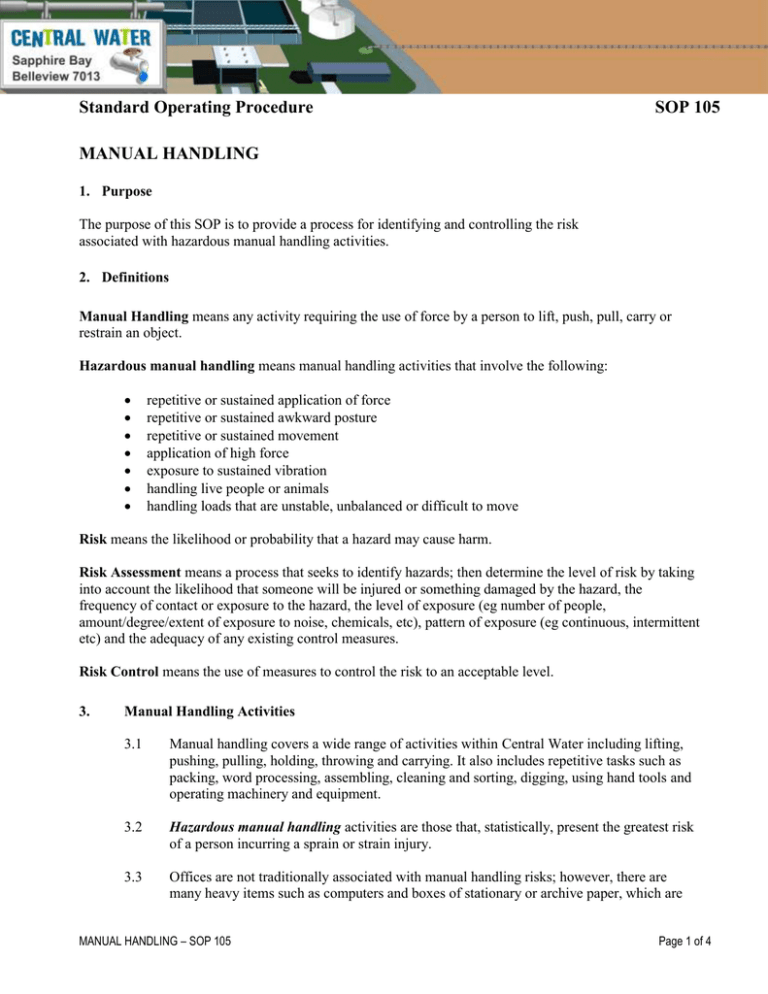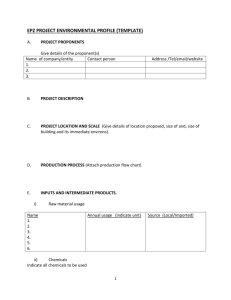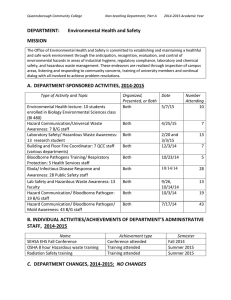Standard Operating Procedure SOP 105 MANUAL HANDLING
advertisement

Standard Operating Procedure SOP 105 MANUAL HANDLING 1. Purpose The purpose of this SOP is to provide a process for identifying and controlling the risk associated with hazardous manual handling activities. 2. Definitions Manual Handling means any activity requiring the use of force by a person to lift, push, pull, carry or restrain an object. Hazardous manual handling means manual handling activities that involve the following: repetitive or sustained application of force repetitive or sustained awkward posture repetitive or sustained movement application of high force exposure to sustained vibration handling live people or animals handling loads that are unstable, unbalanced or difficult to move Risk means the likelihood or probability that a hazard may cause harm. Risk Assessment means a process that seeks to identify hazards; then determine the level of risk by taking into account the likelihood that someone will be injured or something damaged by the hazard, the frequency of contact or exposure to the hazard, the level of exposure (eg number of people, amount/degree/extent of exposure to noise, chemicals, etc), pattern of exposure (eg continuous, intermittent etc) and the adequacy of any existing control measures. Risk Control means the use of measures to control the risk to an acceptable level. 3. Manual Handling Activities 3.1 Manual handling covers a wide range of activities within Central Water including lifting, pushing, pulling, holding, throwing and carrying. It also includes repetitive tasks such as packing, word processing, assembling, cleaning and sorting, digging, using hand tools and operating machinery and equipment. 3.2 Hazardous manual handling activities are those that, statistically, present the greatest risk of a person incurring a sprain or strain injury. 3.3 Offices are not traditionally associated with manual handling risks; however, there are many heavy items such as computers and boxes of stationary or archive paper, which are MANUAL HANDLING – SOP 105 Page 1 of 4 heavy enough to present a potential risk when lifted. Poorly designed work practices with computer keyboard input can also present problems. 4. 3.4 The major hazard arising from inappropriate manual handling is injury to the spine or muscles, commonly the back. Such injuries may prevent that person from being able to conduct certain types of manual handling, or render them susceptible to the same injury at a later stage. 3.5 Another hazard associated with inappropriate manual handling is Musculoskeletal Disorder (also known as RSI, Occupational Overuse Syndrome and Cumulative Trauma Disorder). Such injuries are characterised by symptoms of discomfort or persistent pain in muscles, tendons and other soft tissues, with or without obvious visible symptoms (eg. swelling). Procedure The OHS (Manual Handling) Regulations 1999 require that hazardous manual handling activities be identified, assessed and measures to control the risk of injury be implemented. The regulations also require that formal risk assessments be completed if a manual handling related injury is reported, or before the introduction of a new manual handling task. 4.1 Supervisors are to ensure that hazardous manual handling activities are identified using the Checklist for Identifying Hazardous Manual Handling Tasks (Form 047) at Appendix 1. 4.2 Where a hazardous manual handling activity is identified, the Health, Safety and Systems Coordinator (HSSC) is to be notified. The HSSC will then complete a formal risk assessment using the WorkSafe Manual Handling Risk Assessment Form. 4.3 Copies of completed Manual Handling Risk Assessment Forms are to be retained by the HSSC, and will be used as the basis for the introduction of manual handling risk control measures, including training in the use of the control measure. Appendices: 1. Form 047 Checklist for Identifying Hazardous Manual Handling Tasks 2. WorkSafe Form for Assessing and Controlling Manual Handling Risk MANUAL HANDLING – SOP 105 Page 2 of 4 APPENDIX 1 CHECKLIST FOR IDENTIFYING HAZARDOUS MANUAL HANDLING TASKS IDENTIFICATION CONDUCTED BY: Date: Management Representative: Employee Representative: TASK DESCRIPTION DOES THE TASK INVOLVE ANY OF THE FOLLOWING? Repetitive or sustained application of force? The use of force repeatedly over a period of time The use of force continuously over a period of time Repetitive or sustained awkward posture? Any part of the body is in an unnatural or uncomfortable position Repetitive or sustained movement? The same parts of the body are used to repeat movements over a period of time Application of high force? Persons are finding the task difficult because of the effort it requires Exposure to sustained vibration? Vibration transferred to the persons body from tools or machinery Handling live people or animals? Handling loads that are unstable, unbalanced or difficult to move? Loads that are large, slippery, floppy, sharp, hot, cold, toxic or unpleasant If one or more boxes are ticked then a manual handling risk assessment is to be conducted using the WorkSafe Manual Handling Risk Assessment Form and assistance sought from the Health, Safety and Systems Coordinator. This checklist is to be reviewed whenever changes are introduced into the workplace or when symptoms of manual handling injuries are reported. This task has been identified as involving Hazardous Manual Handling and has been / is to be referred to the Health Safety & Systems Coordinator for Manual Handling Risk Assessment: Name MANUAL HANDLING – SOP 105 Signature Date Page 3 of 4 MANUAL HANDLING – SOP 105 Page 4 of 4


